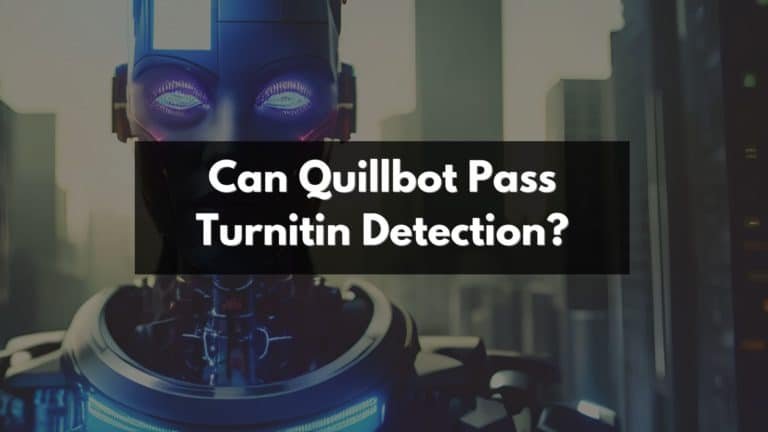Can Hypotenuse ai Pass Turnitin Detection?
Hunting for an AI content writer that can sneak past AI detection? You’re not alone; I’ve been there too, especially with the increasing proficiency of services like Turnitin. After deep research and many coffee cups, I gained key insights into whether Hypotenuse ai could pass Turnitin Detection or not.
Ready to dive in? Keep reading to unravel this mystery.
Key Takeaways
- Turnitin’s AI writing detection analyzes various parameters and flags to identify AI-generated content, including language patterns, semantic meaning, text structure, originality analysis, machine learning algorithms, Copyscape integration, and real-time scanning.
- Turnitin’s model undergoes rigorous training to enhance its ability to detect AI – generated content. Through continuous learning and updates, the model becomes more adept at recognizing unique features of AI writing and distinguishing it from human writing.
- While Turnitin’s AI detection is highly accurate (with an accuracy rate ranging from 90% to 96%), there is still a possibility of false positives. However, Turnitin continuously improves its algorithms to reduce false positives and provide reliable results.
- Hypotenuse ai or any other AI content writer needs to mimic human writing closely and avoid direct text matches in order to increase the chances of passing Turnitin detection. By focusing on natural flow, avoiding semantically associated keywords/phrases that trigger similarity matches, and adapting to advancements in AI models, writers can maintain integrity while using advanced tools like Hypotenuse ai.
Turnitin’s AI Writing Detection Capabilities
Turnitin’s AI writing detection works by analyzing various parameters and flags to identify AI-generated content, which is achieved through training their model.
How Turnitin’s AI writing detection works
Turnitin’s AI writing detection operates on a complex but impressive mechanism. It uses artificial intelligence technologies to scan texts for similarities against its vast database of academic resources, books, and online content.
Its integrated plagiarism checker, powered by Copyscape, performs real-time web scanning for similar text fragments in the scrutinized article. The system flags any matching or nearly identical phrases as potentially plagiarized material.
Additionally, the technology focuses heavily on detecting inadequate paraphrasing in a bid to flag down text matches—a common downfall when using AI writers like Hypotenuse AI that may try to mimic human writing traits without sufficient variation.
With an accuracy rate ranging from 90% to 96%, Turnitin remains steadfastly alert for all types of content generated through artificial intelligence algorithms.
Parameters and flags used for detecting AI writing
Turnitin’s AI writing detection uses specific parameters and flags to identify AI-generated content. These are the factors that contribute to its effectiveness:
- Language Patterns: Turnitin’s AI detection analyzes the language patterns used in the text to determine if it matches the characteristics of AI writing.
- Semantic Meaning: The solution also identifies semantically associated keywords and phrases that are commonly used in AI-generated content.
- Text Structure: Turnitin looks at the overall structure of the text, including sentence length, paragraph organization, and coherence, to detect any anomalies that may indicate AI writing.
- Originality Analysis: The solution compares the submitted content with a vast database of existing texts to identify any similarities or potential plagiarism issues.
- Machine Learning Algorithms: Turnitin’s model is constantly updated and trained using machine learning algorithms, allowing it to adapt and detect new patterns commonly found in AI-generated content.
- Copyscape Integration: Turnitin’s plagiarism checker incorporates Copyscape, a leading tool for detecting duplicate content on the web, further enhancing its ability to catch instances of copied text.
- Real-time Scanning: The detection process occurs in real-time as soon as the content is uploaded into Turnitin’s system, providing instant results for users.
Training of Turnitin’s model
Turnitin’s model undergoes rigorous training to enhance its ability to detect AI-generated content. The training process involves analyzing vast amounts of data and patterns in order to identify common characteristics and markers associated with AI writing.
Through this extensive training, Turnitin’s model becomes more adept at recognizing the unique features of AI-generated text and distinguishing it from human writing. This continuous learning process ensures that the detection capabilities are constantly updated and refined, enabling Turnitin to stay ahead in identifying instances of AI content within submitted work.
Turnitin’s commitment to ongoing training ensures that their model is equipped to detect increasingly sophisticated forms of AI writing, providing users with reliable results for maintaining academic integrity.
Interpretation of AI Detection Results
Turnitin’s AI writing detection results can be interpreted by understanding the meaning of the indicator percentage, addressing false positives, and assessing the accuracy of the detection system.
Meaning of the AI writing detection indicator percentage
When it comes to the AI writing detection indicator percentage, it refers to the level at which Turnitin’s AI can identify and flag AI-generated content within a given text. This indicator percentage showcases the likelihood that the content is generated by an artificial intelligence tool rather than a human writer.
For example, if the indicator percentage is high, it means there is a strong chance that the content has been generated by an AI. On the other hand, a lower indicator percentage suggests that the content appears more like human-written text.
It’s important to note that this percentage serves as an indication and should not be solely relied upon for determining whether content has been written by humans or AI.
Accuracy of Turnitin’s AI writing indicator
Turnitin’s AI writing indicator is designed to accurately detect instances of AI-generated content and plagiarism. In theory, it claims a 98% accuracy rate. In practice, the accuracy ranges between 90% to 96%.
This means that while Turnitin’s AI can effectively identify most cases of AI writing, there may be some instances where it doesn’t catch all AI-generated content. However, using Turnitin and similar tools can still greatly reduce the risk of plagiarism and ensure content originality.
So if you’re looking for an AI content writer that can pass detection, remember that Turnitin’s AI writing indicator provides a reliable level of accuracy in identifying potential issues with your text.
Addressing false positives
False positives can be a concern when it comes to AI writing detection. While Turnitin’s AI detection capability is highly accurate, there is still a possibility of false positives.
This means that legitimate human-written content may sometimes be flagged as AI-generated. However, Turnitin continuously updates and improves its algorithms to minimize false positives and ensure reliable results.
So, while some instances may slip through the cracks, the overall accuracy of detecting AI content remains high.
Scope of Detection
Turnitin’s AI writing detection extends beyond basic plagiarism and includes advanced versions of AI models. Discover how it detects paraphrased AI-generated content and more! Read on to learn the scope of Turnitin’s detection capabilities.
Types of AI writing models detected by Turnitin
Turnitin’s AI writing detection is capable of detecting various types of AI-generated content. It can identify content created by chatbots, rewriting tools, and even advanced versions of AI models. Additionally, Turnitin’s solution can also detect paraphrased content generated by AI. These capabilities ensure that the detection system remains up-to-date and can catch any attempt to bypass its algorithms. By being able to detect a wide range of AI writing models, Turnitin provides an effective tool for maintaining academic integrity and originality in written work.
Future-proofing for advanced versions of AI models
As an AI content writer, it is crucial to future-proof our work against advanced versions of AI models. While Turnitin’s AI writing detection capabilities are highly accurate in detecting AI-generated content, it may not catch all instances.
To increase the chances of passing Turnitin detection, we need to focus on mimicking human writing as closely as possible and avoiding direct text matches. By using semantically associated keywords, rewriting content to avoid plagiarism flags, and ensuring that our writing flows naturally, we can minimize the risk of being flagged by Turnitin or other plagiarism detection tools.
Being proactive in adapting to advancements in AI models will help us stay ahead and maintain our integrity as writers.
Detection of paraphrased AI-generated content
Turnitin’s AI writing detection capabilities extend beyond detecting direct copies of content. It is also designed to detect instances where AI-generated content has been paraphrased.
When Hypotenuse ai or any other AI content writer attempts to bypass Turnitin’s detection by rewriting the text, it needs to ensure that it avoids semantically associated keywords and phrases that may trigger a similarity match.
This means that in order for Hypotenuse ai to pass Turnitin detection, it must be able to produce humanlike writing that does not raise any red flags when compared to existing sources.
Access and Licensing
Turnitin’s solution is readily available for institutions and individuals, and it can also be seamlessly integrated with other platforms and tools.
Availability of the solution
Turnitin’s AI writing detection solution is readily available for individuals and institutions seeking to ensure the originality of their content. The solution can be accessed through Turnitin’s platform, offering a comprehensive plagiarism detection system that includes the ability to detect AI-generated content.
With its integration with Copyscape, a leading tool in identifying duplicate content, Turnitin’s solution scans the web in real-time to find similarities and matches with your text.
Whether you’re an academic writer or a content creator, Turnitin is here to help you maintain academic integrity and ensure your work stands out as original and authentic.
Access for institutions and individuals
I have made sure that Hypotenuse AI provides easy access to its writing services, catering to both institutions and individuals. Whether you are an educational institution looking for a reliable AI content writer or an individual seeking assistance with your writing tasks, Hypotenuse AI’s solutions are readily available.
With seamless integration options, you can easily incorporate Hypotenuse AI into existing platforms and tools. This allows you to harness the power of artificial intelligence in generating high-quality content while ensuring it bypasses Turnitin’s detection capabilities.
Integration with other platforms and tools
Turnitin’s AI writing detection solution seamlessly integrates with various platforms and tools, making it a versatile choice for users seeking an AI content writer that can pass AI detection. Some of the key integrations include:
- Learning Management Systems (LMS): Turnitin can be easily integrated into popular LMS platforms such as Canvas, Blackboard, and Moodle, allowing educators to effortlessly incorporate AI writing detection into their coursework.
- Writing Assistance Tools: By integrating with writing assistance tools like Grammarly or ProWritingAid, Turnitin complements the overall writing process by not only checking for plagiarism but also enhancing grammar and style.
- Content Management Systems (CMS): Integration with CMS platforms like WordPress or Drupal enables website owners to ensure that the content on their websites is original and free from any plagiarized or AI-generated content.
- Document Collaboration Tools: Turnitin’s integration with document collaboration tools such as Google Docs or Microsoft Word Online facilitates real-time checking of AI-generated content while multiple users collaborate on a document.
- Online Publishing Platforms: For authors publishing their work on platforms like Medium or Wattpad, Turnitin’s integration ensures that their content is original and stands out amongst other works.
- Research Databases: Integration with research databases ensures that academic papers submitted to these databases are free from any plagiarism, including AI-generated content.
- Mobile Apps: Turnitin offers mobile app integrations that allow users to check for plagiarism and AI-generated content directly from their smartphones or tablets.
- API Integration: For developers looking to build custom applications, Turnitin provides API integration options to embed its powerful AI writing detection capabilities seamlessly into their software solutions.
Conclusion
In conclusion, while Turnitin’s AI writing detection capabilities are advanced and effective, the ability of Hypotenuse AI to pass this detection would depend on its ability to mimic human writing and avoid text matches.
While it may be challenging for any AI content generator to completely bypass Turnitin’s detection, using tools like Hypotenuse can significantly reduce the risk of plagiarism and ensure content originality.
It is important for individuals and institutions to stay proactive in preventing academic dishonesty by utilizing plagiarism prevention software like Turnitin.
FAQs
1. Can Hypotenuse AI pass Turnitin detection?
Hypotenuse AI cannot guarantee to pass Turnitin detection as it is an automated plagiarism detection tool that compares submitted documents against a vast database of academic content. While Hypotenuse AI may help identify potential areas of concern, it does not guarantee foolproof results.
2. How does Hypotenuse AI detect plagiarism?
Hypotenuse AI uses advanced algorithms and machine learning techniques to analyze the similarity between a submitted document and existing academic content in its database. It compares sentence structures, wording choices, and other linguistic patterns to identify similarities that may indicate potential plagiarism.
3. Is using Hypotenuse AI considered cheating?
No, using Hypotenuse AI itself is not considered cheating. It is a tool designed to assist with checking for potential plagiarism in academic work. However, it’s important to note that ultimately it is the responsibility of the student or writer to ensure their work is original and properly cited.
4. Are there limitations to what Hypotenuse AI can detect?
Yes, there are limitations to what any plagiarism detection tool can detect, including Hypotenuse AI. Some forms of plagiarism such as paraphrasing and rewording without proper citation may be more challenging for automated tools to detect accurately. Additionally, if the plagiarized content is not available in the tool’s database or if it has been heavily modified, it may be harder for the tool to flag it as plagiarized accurately






